-
ORIGINAL ARTICLE08-21-2023
Percepciones, maltrato y religión como predictores del impacto psicoemocional en enfermeros durante la pandemia COVID-19
Revista Brasileira de Enfermagem. 2023;76(3):e20220768
Abstract
ORIGINAL ARTICLEPercepciones, maltrato y religión como predictores del impacto psicoemocional en enfermeros durante la pandemia COVID-19
Revista Brasileira de Enfermagem. 2023;76(3):e20220768
DOI 10.1590/0034-7167-2022-0768es
Views0See moreRESUMEN
Objetivos:
analizar la relación entre percepciones, maltrato y religión con el impacto psicoemocional en enfermeros durante la pandemia por covid-19.
Métodos:
estudio transversal descriptivo-analítico. Fue realizado entre los años 2020 y 2021; se encuestó a 319 enfermeros asistenciales de Perú mediante DASS-21; se evaluaron asociaciones mediante Rho de Spearman y regresión múltiple.
Resultados:
el 18,5 % presentó algún grado de estrés; el 50,2 %, ansiedad y el 29,1 %, depresión. La experiencia de maltrato, la autopercepción de la salud mental y la religión fueron predictores de estrés, ansiedad y depresión. El tiempo de experiencia laboral predice el estrés y ansiedad. Además, la autopercepción de la información y el género fueron predictores de la depresión.
Conclusiones:
los enfermeros peruanos presentaron altos niveles de estrés, ansiedad y depresión; y este impacto psicoemocional estuvo asociado a las percepciones, experiencias de maltrato y la religión.
-
ORIGINAL ARTICLE08-11-2023
Agreement with COVID-19 disinformation among Portuguese-speaking older adults: an international study
Revista Brasileira de Enfermagem. 2023;76:e20230091
Abstract
ORIGINAL ARTICLEAgreement with COVID-19 disinformation among Portuguese-speaking older adults: an international study
Revista Brasileira de Enfermagem. 2023;76:e20230091
DOI 10.1590/0034-7167-2023-0091
Views0See moreABSTRACT
Objectives:
to assess agreement with COVID-19 disinformation among Portuguese-speaking individuals aged 50 years or older.
Methods:
a descriptive and analytical study involving 1,214 older adults born in Portuguese-speaking countries. Data collection occurred through online information mining to recognize COVID-19 and disinformation content, and the application of a structured questionnaire.
Results:
agreement with disinformation content was 65.2%. Residing outside Brazil is a protective factor for agreement with disinformation content, and those who believe in the truthfulness of the information sources they receive were 31% more likely to agree with disinformation content.
Conclusions:
there is a high prevalence of disinformation among the older population in two Portuguese-speaking countries, which should raise the attention of healthcare professionals and guide coping strategies.
-
ORIGINAL ARTICLE08-07-2023
Professional burnout and patient safety culture in Primary Health Care
Revista Brasileira de Enfermagem. 2023;76(3):e20220311
Abstract
ORIGINAL ARTICLEProfessional burnout and patient safety culture in Primary Health Care
Revista Brasileira de Enfermagem. 2023;76(3):e20220311
DOI 10.1590/0034-7167-2022-0311
Views0ABSTRACT
Objectives:
to analyze the association between the risk of occupational exhaustion (burnout) and safety culture in Primary Health Care.
Methods:
ross-sectional study conducted in 18 Primary Health Care Units in the Northeast of Brazil. Three questionnaires were used: sociodemographic, Maslach Burnout Inventory, and the Medical Office Survey on Patient Safety Culture. The study was approved by the Research Ethics Committee.
Results:
seventy-eight healthcare workers participated, of which 64.1% presented a reduced risk of burnout; and 11.5%, a high risk (p=0.000). The following were identified as weakened dimensions of safety culture: Work pressure and pace; Owner, managing partners, leadership support; Overall ratings on quality; and Overall rating on patient safety.
Conclusions:
an association was found between low risk of developing burnout syndrome and positive evaluation of safety culture.
Keywords:Health PersonnelOccupational BurnoutOrganizational CulturePatient SafetyPrimary Health CareSee more -
ORIGINAL ARTICLE08-07-2023
Undergraduate nursing students’ knowledge and experience in infusion therapy and peripheral vascular acces
Revista Brasileira de Enfermagem. 2023;76(3):e20220219
Abstract
ORIGINAL ARTICLEUndergraduate nursing students’ knowledge and experience in infusion therapy and peripheral vascular acces
Revista Brasileira de Enfermagem. 2023;76(3):e20220219
DOI 10.1590/0034-7167-2022-0219
Views0ABSTRACT
Objectives:
to analyze the knowledge and experience of undergraduate nursing students regarding infusion therapy and peripheral vascular access.
Methods:
descriptive, cross-sectional, analytical study with 123 undergraduate nursing students who answered a semi-structured instrument.
Results:
the majority were women, with a median age of 51 years old; 87% considered the teaching received insufficient to perform in clinical practice. The mean overall knowledge score was 78.1 (SD± 8.97). The themes catheter flushing and lock (38.1%), catheter selection (34.2%), infusion equipment (30.9%) and insertion site (30.9%) presented a significant number of errors.
Conclusions:
practical classes and execution of procedures in health services were predictors for a better knowledge about infusion therapy and vascular access by undergraduate nursing students.
Keywords:Education, NursingEducation, Nursing, Diploma ProgramsKnowledgeNursingVascular Access DevicesSee more -
Chemsex and its repercussions on the health of men who have sex with men (MSM): a global health perspective
Revista Brasileira de Enfermagem. 2023;76(3):e20230004
Abstract
Chemsex and its repercussions on the health of men who have sex with men (MSM): a global health perspective
Revista Brasileira de Enfermagem. 2023;76(3):e20230004
DOI 10.1590/0034-7167-2023-0004
Views0See moreABSTRACT
Objectives:
to discuss the repercussions of chemsex on the health of men who have sex with men (MSM), contextualizing it in a global health scenario and pointing out the implications for nursing care.
Methods:
theoretical-reflexive study based on scientific literature and concepts related to global health.
Results:
we present the epidemiology of the chemsex phenomenon, the main demands of the field, the reasons why it has become a global public health problem, and the implications for nursing practice.
Final Considerations:
chemsex is growing in all age groups of MSM and is globally benefiting from location-based applications to gain magnitude, finding an important potential audience in the migrant population. Nursing structures can help accelerate the proposal and implementation of biomedical and behavioral measures to address chemsex in its entirety, qualifying care and inducing teamwork with interprofessional collaboration.
-
ORIGINAL ARTICLE08-07-2023
Perception of Portuguese nurses: clinical supervision and quality indicators in nursing care
Revista Brasileira de Enfermagem. 2023;76(3):e20220656
Abstract
ORIGINAL ARTICLEPerception of Portuguese nurses: clinical supervision and quality indicators in nursing care
Revista Brasileira de Enfermagem. 2023;76(3):e20220656
DOI 10.1590/0034-7167-2022-0656
Views0See moreABSTRACT
Objectives:
to describe nurses’ perception of the influence of clinical supervision on improving quality indicators in nursing care.
Methods:
exploratory research with a qualitative approach, carried out with 16 nurses using the focus group. Data processing emerged from lexicographical textual analysis, resorting to Descending Hierarchical Classification and similarity analysis.
Results:
80.0% retention of 185 text segments with six-class construction. The words were represented by four graphs (supervisor, audit, care, and process); and three subgraphs (implementation, sharing and knowledge).
Final Considerations:
in the perception of nurses, supervision influences quality indicators in nursing care.
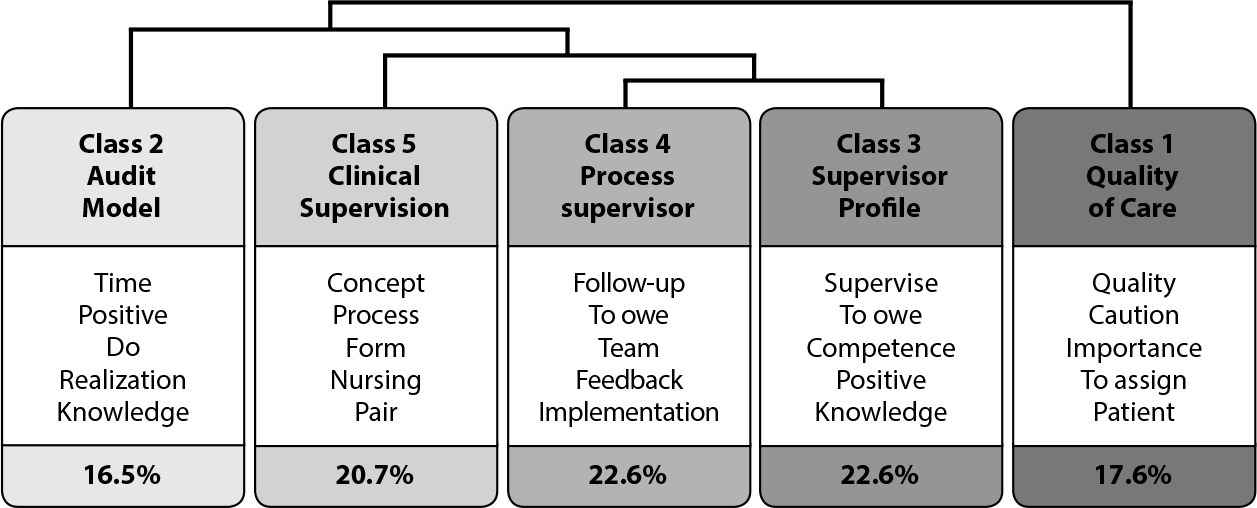
-
REVIEW08-07-2023
Early diagnosis of HIV/aids infection: concept analysis
Revista Brasileira de Enfermagem. 2023;76(3):e20220565
Abstract
REVIEWEarly diagnosis of HIV/aids infection: concept analysis
Revista Brasileira de Enfermagem. 2023;76(3):e20220565
DOI 10.1590/0034-7167-2022-0565
Views0ABSTRACT
Objectives:
to analyze the concept of “early diagnosis of HIV/Aids infection” in light of Walker and Avant’s conceptual analysis model.
Methods:
concept analysis study based on the framework proposed by Walker and Avant, instrumented by a scoping review conducted in April 2022, following the recommendations of the Joanna Briggs Institute and checklist Preferred Reporting Items for Systematic reviews and Meta-Analyses extension for Scoping Reviews. The search was made in eight data sources, obtaining sixteen articles.
Results:
the study found homosexual intercourses, early examination, anti-HIV antibodies, CD4 count, and sexually transmitted infection as the main attributes of the concept. As antecedents: information, risky behavior, unprotected sexual relations, prevention, and access to the service. As main consequences: antiretroviral treatment, seroconversion, transmission, and consultations.
Final Considerations:
the study approached the circumstantial situations of the theme, its attributes, antecedents, and consequences, qualifying the work process based on knowledge of nursing practice.
Keywords:Acquired Immunodeficiency SyndromeAIDS SerodiagnosisEarly DiagnosisHIV InfectionsHospital UnitsSee more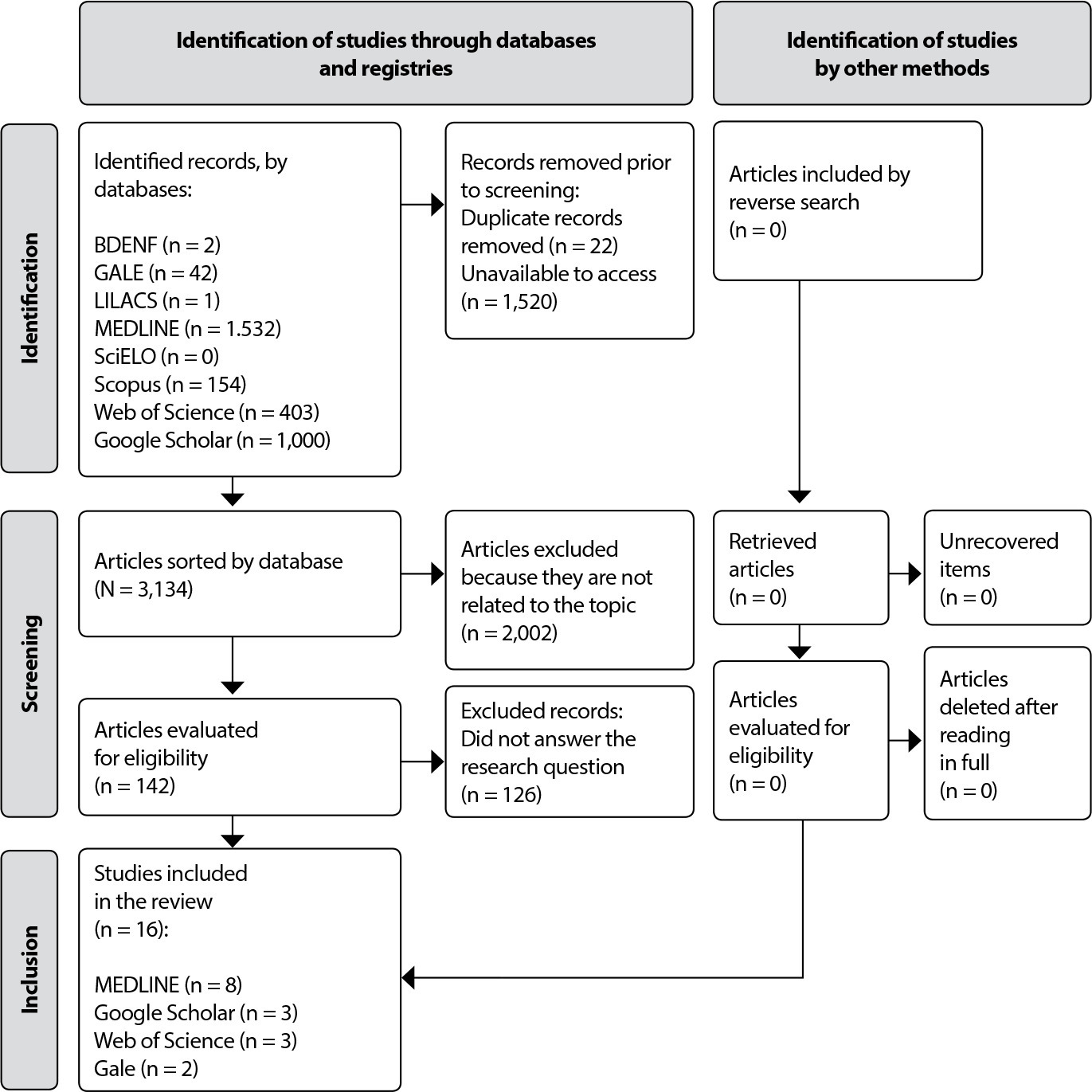
-
ORIGINAL ARTICLE08-07-2023
King’s Parkinson’s Disease Pain Questionnaire: reliability and convergent construct validity
Revista Brasileira de Enfermagem. 2023;76(3):e20220379
Abstract
ORIGINAL ARTICLEKing’s Parkinson’s Disease Pain Questionnaire: reliability and convergent construct validity
Revista Brasileira de Enfermagem. 2023;76(3):e20220379
DOI 10.1590/0034-7167-2022-0379
Views0See moreABSTRACT
Objectives:
to assess the evidence of reliability and convergent construct validity of the King’s Parkinson’s Disease Pain Questionnaire.
Methods:
psychometric study of 75 older adults with Parkinson’s disease. The instrument was applied by two researchers separately and reapplied by one researcher 15 days later. In terms of reliability, internal consistency was assessed using the Cronbach’s alpha test and stability using the intraclass correlation coefficient. Scores of the King’s Parkinson’s Disease Pain Questionnaire were compared to those of the Geriatric Pain Measure in the assessment of construct validity.
Results:
the mean Cronbach’s alpha obtained between the three assessments was above 0.60, the intraclass correlation between the three assessments was above 0.90, and there was a weak but significant correlation between the two applied scales.
Conclusions:
the instrument showed adequate evidence of convergent construct validity and reliability, and can be used in clinical practice.
-
REVIEW09-21-2020
Middle range theory for the nursing diagnosis Excess Fluid Volume in pregnant women
Revista Brasileira de Enfermagem. 2020;73:e20190334
Abstract
REVIEWMiddle range theory for the nursing diagnosis Excess Fluid Volume in pregnant women
Revista Brasileira de Enfermagem. 2020;73:e20190334
DOI 10.1590/0034-7167-2019-0334
Views1See moreABSTRACT
Objective:
To stablish a middle range theory for the understanding of the causal mechanisms and clinical consequentes of the nursing diagnosis Excess Fluid Volume (00026) among pregnant women.
Method:
The Middle Range Theory was constructed in five stages: defining of construction approach, establishing main concepts, elaborating propositions, developing a pictorial diagram, and establishing the causal relationships and evidence for practice of the Middle Range Theory.
Results:
We identified 14 clinical indicators and 6 causal factors of Excess Fluid Volume. A pictorial diagram was developed and relationships between Excess Fluid Volume elements were established with 6 propositions for them.
Conclusion:
The Middle Range Theory included both physiological and pathological conditions to explain Excess Fluid Volume. This Middle Range Theory might help in the better understanding of interactions between causal factors and clinical indicators of Excess Fluid Volume.
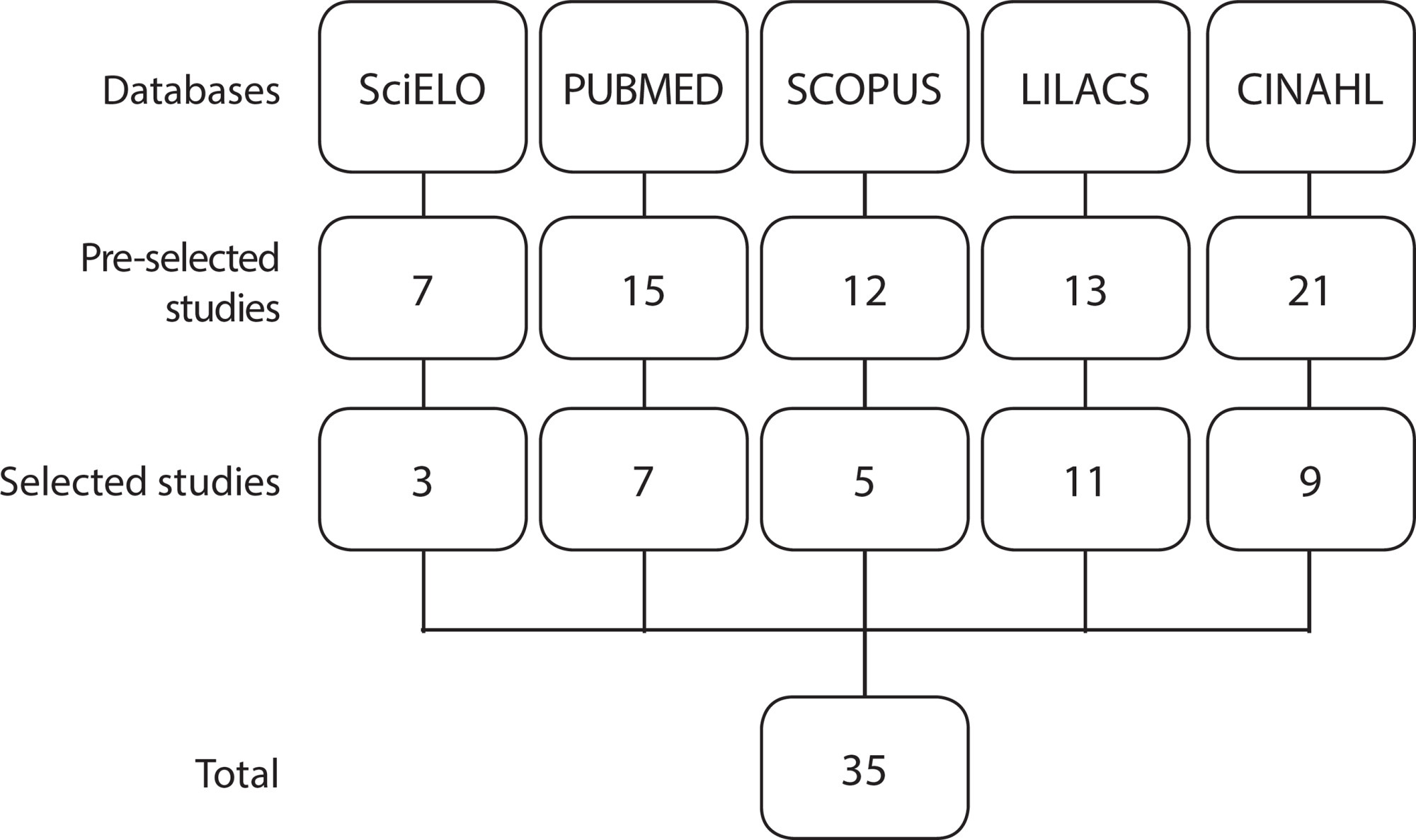
-
ORIGINAL ARTICLE12-21-2020
Development of an appearance validity instrument for educational technology in health
Revista Brasileira de Enfermagem. 2020;73:e20190559
Abstract
ORIGINAL ARTICLEDevelopment of an appearance validity instrument for educational technology in health
Revista Brasileira de Enfermagem. 2020;73:e20190559
DOI 10.1590/0034-7167-2019-0559
Views1ABSTRACT
Objectives:
to develop and evaluate the convergence of the instrument for the appearance validity of educational technologies in health.
Methods:
methodological study conducted in two steps. In step 1, the instrument items were developed, with subsequent content validity by nine specialists in the development of educational technologies in health. In step 2, the convergent validity between another instrument and the appearance instrument was performed. Correlation results above r> 0.3 and p <0.05 were considered as plausible convergent validity.
Results:
the ten items of the initial version of the appearance instrument were submitted to content validity that resulted in a final version with 12 items (Content Validity Index = 0.93). The correlation indexes were strong with the objective and appearance domains; moderate with motivation, organization and total; and weak with writing style.
Conclusions:
the appearance instrument demonstrated content validity and convergent validity, in addition to a strong correlation with the other instrument.
Keywords:Educational TechnologyHealth EducationMethodological Research in NursingTechnological DevelopmentValidation StudiesSee more -
EXPERIENCE REPORT08-19-2019
Hypothermia post-cardiopulmonary resuscitation with low inputs: an experience report
Revista Brasileira de Enfermagem. 2019;72(4):1114-1118
Abstract
EXPERIENCE REPORTHypothermia post-cardiopulmonary resuscitation with low inputs: an experience report
Revista Brasileira de Enfermagem. 2019;72(4):1114-1118
DOI 10.1590/0034-7167-2017-0771
Views1ABSTRACT
Objective:
to report the experience of conducting directed temperature control of a post-cardiopulmonary resuscitation patient, with reduced and basic inputs available at the institution.
Method:
an experience report of directed temperature control in patient (age 15 years), after four hours of cardiopulmonary resuscitation in an Intensive Care Unit of a hospital in São Paulo State countryside in 2016, according to the protocol suggested by the American Heart Association, in 2015. There were applications of cold compresses, plastic bags with crushed ice and rectal temperature control.
Results:
after eight hours, temperature had reached 93.2 ºF. Body cooling was maintained for 24 hours. However, bags with crushed ice were used in the first 6 hours.
Conclusion:
conduct of nurses to obtain the body cooling with reduced and basic inputs was effective during the stay at the Intensive Care Unit.
Keywords:Body Temperature RegulationCardiopulmonary ResuscitationHeart ArrestHypothermia InducedIntensive Care UnitsSee more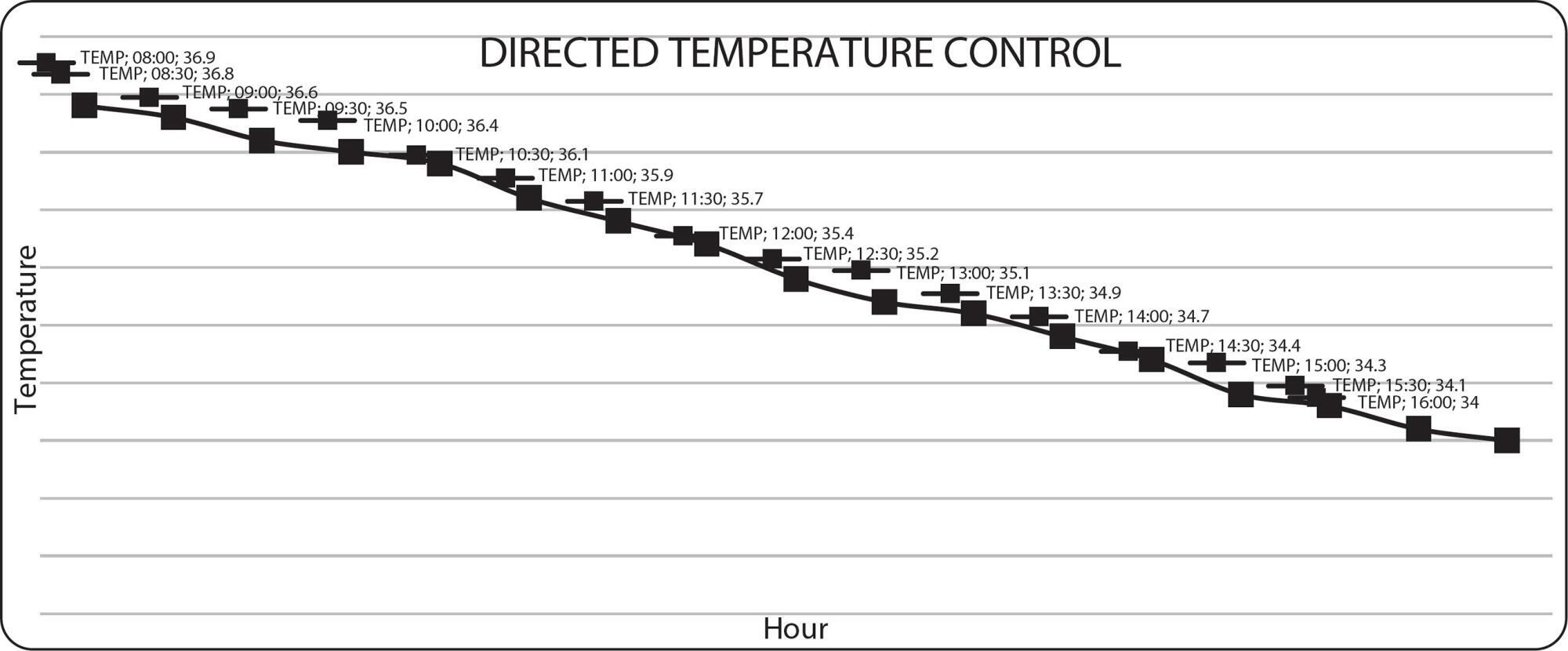
-
ORIGINAL ARTICLE05-28-2021
Managed clinical protocol: impact of implementation on sepsis treatment quality indicators
Revista Brasileira de Enfermagem. 2021;74(2):e20200282
Abstract
ORIGINAL ARTICLEManaged clinical protocol: impact of implementation on sepsis treatment quality indicators
Revista Brasileira de Enfermagem. 2021;74(2):e20200282
DOI 10.1590/0034-7167-2020-0282
Views1See moreABSTRACT
Objectives:
to assess the impact of the implementation of a managed sepsis protocol on quality indicators of treatment for septic patients in an emergency department of a university hospital.
Methods:
an observational epidemiological study involving septic patients. The study was divided into two phases, pre-intervention and intervention, resulting from the implementation of the managed sepsis protocol. The study variables included sepsis treatment quality indicators. The results were statistically analyzed using the program Epi InfoTM.
Results:
the study sample included 631 patients, 95 from pre-intervention phase and 536 from intervention phases. Implementing the protocol increased patients’ chances of receiving the recommended treatment by 14 times. Implementing the protocol reduced the hospitalization period by 6 days (p <0.001) and decreased mortality (p <0.001).
Conclusions:
this study showed that implementing the managed protocol had an impact on the improvement of sepsis treatment quality indicators.
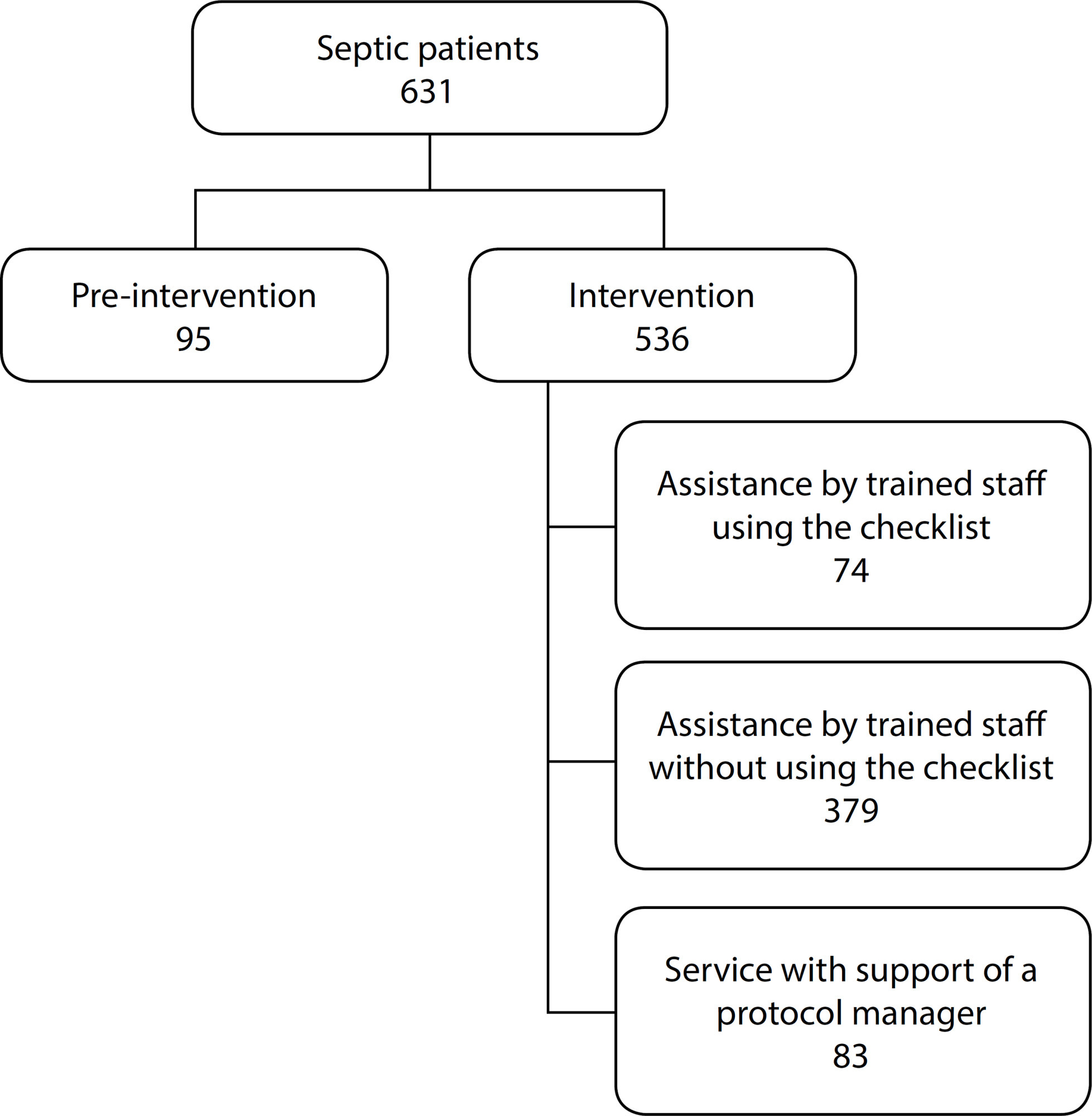
-
ORIGINAL ARTICLE05-28-2021
Prevalence and severity levels of post-radical prostatectomy incontinence: different assessment instruments
Revista Brasileira de Enfermagem. 2021;74(2):e20200692
Abstract
ORIGINAL ARTICLEPrevalence and severity levels of post-radical prostatectomy incontinence: different assessment instruments
Revista Brasileira de Enfermagem. 2021;74(2):e20200692
DOI 10.1590/0034-7167-2020-0692
Views1See moreABSTRACT
Objectives:
to analyze urinary incontinence prevalence and severity in prostatectomized men assessed by three different instruments.
Methods:
a cross-sectional study was conducted with 152 men. The pad test, pad used, and International Consultation on Incontinence Questionnaire – Short Form (self-report) were considered. Data were analyzed using Spearman’s correlation, Kappa index, considering a significance level of 0.05.
Results:
urinary incontinence prevalence was 41.4%, 46.7% and 80.3% according to pad used, pad test and self-report. Positive correlations and moderate to poor agreement were found between the instruments. As for severity, most participants had mild incontinence. The largest number of cases of mild and severe incontinence was identified by self-report.
Conclusions:
the self-report showed higher values for prevalence of mild and severe severity levels. Through the identified differences, we propose that the objective assessment (pad used and pad test) be associated with individuals’ perception (self-report) to better estimate prevalence and severity.

-
ORIGINAL ARTICLE05-28-2021
Cultural adaptation and validation of an instrument about nursing critical thinking skills
Revista Brasileira de Enfermagem. 2021;74(2):e20200720
Abstract
ORIGINAL ARTICLECultural adaptation and validation of an instrument about nursing critical thinking skills
Revista Brasileira de Enfermagem. 2021;74(2):e20200720
DOI 10.1590/0034-7167-2020-0720
Views1See moreABSTRACT
Objectives:
to validate the Nursing Critical Thinking in Clinical Practice Questionnaire regarding cultural aspects and metric properties.
Methods:
a methodological research carried out through cross-cultural adaptation, face and content validity, dimensional construct and known groups validity, test-retest reliability and internal consistency. 511 nurses from four hospitals participated in the study, of which 54 participated in retest.
Results:
the instrument validation for Brazilian Portuguese maintained equivalences, according to the original version. The dimensional validity demonstrated adjustment to the tetrafactorial structure of the original version (GFI=0.69). There were statistically significant differences in critical thinking skills between nurses with graduate degrees and who undertook training, reading articles, developing research and working in an institution with a longer time implementation of the Nursing Process. The instrument showed temporal stability (ICC 073-0.84; p<0.001) and adequate internal consistency (α=0.97).
Conclusions:
the instrument proved to be valid and reliable for the studied population.
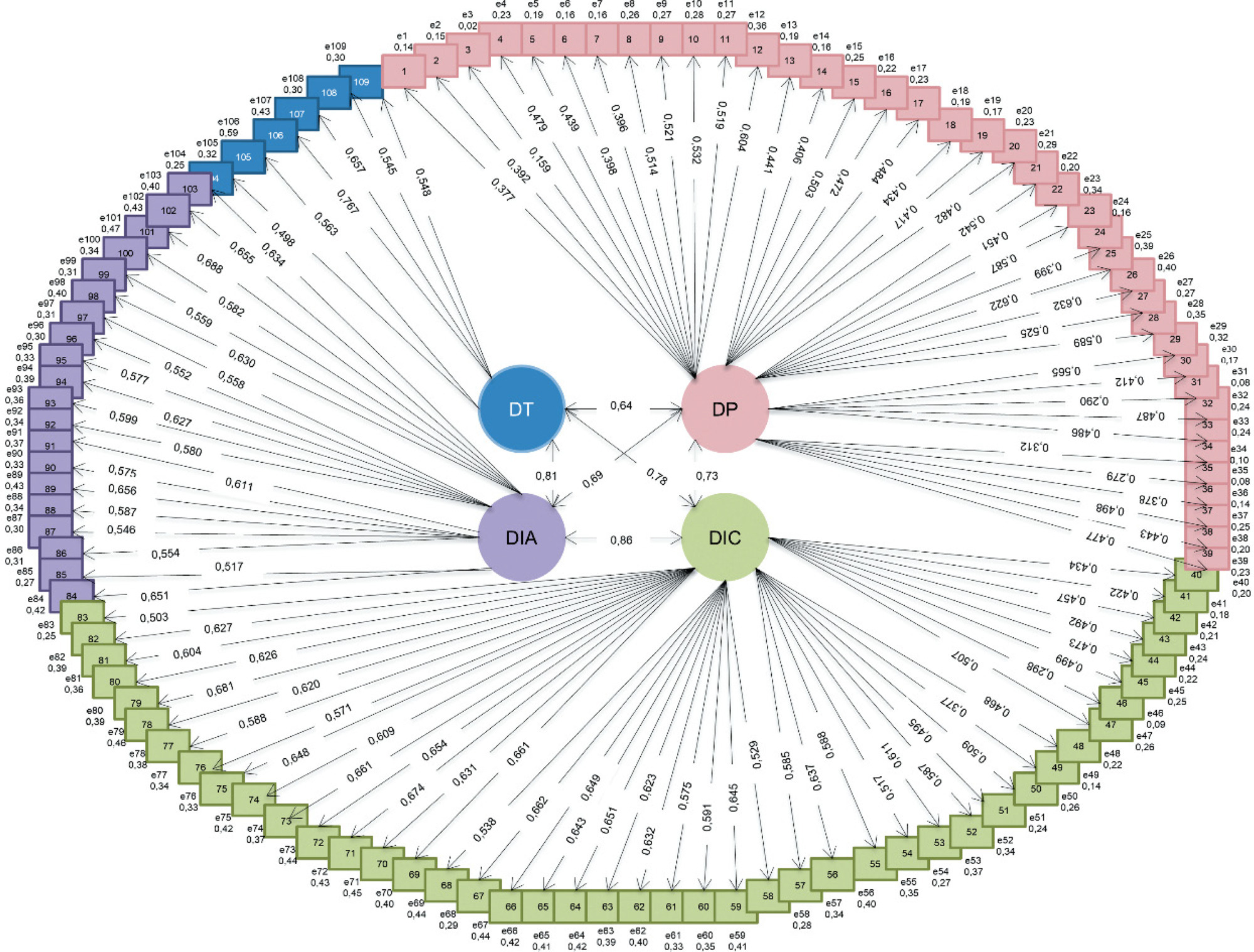
-
REVIEW07-09-2021
Breast cancer screening in Primary Health Care in Brazil: a systematic review
Revista Brasileira de Enfermagem. 2021;74(3):e20200995
Abstract
REVIEWBreast cancer screening in Primary Health Care in Brazil: a systematic review
Revista Brasileira de Enfermagem. 2021;74(3):e20200995
DOI 10.1590/0034-7167-2020-0995
Views1See moreABSTRACT
Objectives:
to analyze care strategies for breast cancer screening in Primary Health Care in Brazil.
Methods:
this is a systematic review following the Cochrane Collaboration recommendations.
Results:
among 355 manuscripts, five were eligible. The patient navigation program by Community Health Agent stood out with the best result, among the strategies: flexibility of goals considering viability; community engagement; team training; active search of the target population by Community Health Agent; request for mammography by physicians; actions integrated to women’s health; monitoring of mammography results, absent users, and population coverage by physician and nurse; and assessment of criteria for requesting screening mammography by means of an information system. The population coverage rate in the program ranged from 23% to 88%.
Conclusions:
Primary Health Care in Brazil presents devices with potential to induce the production of care for breast cancer screening.
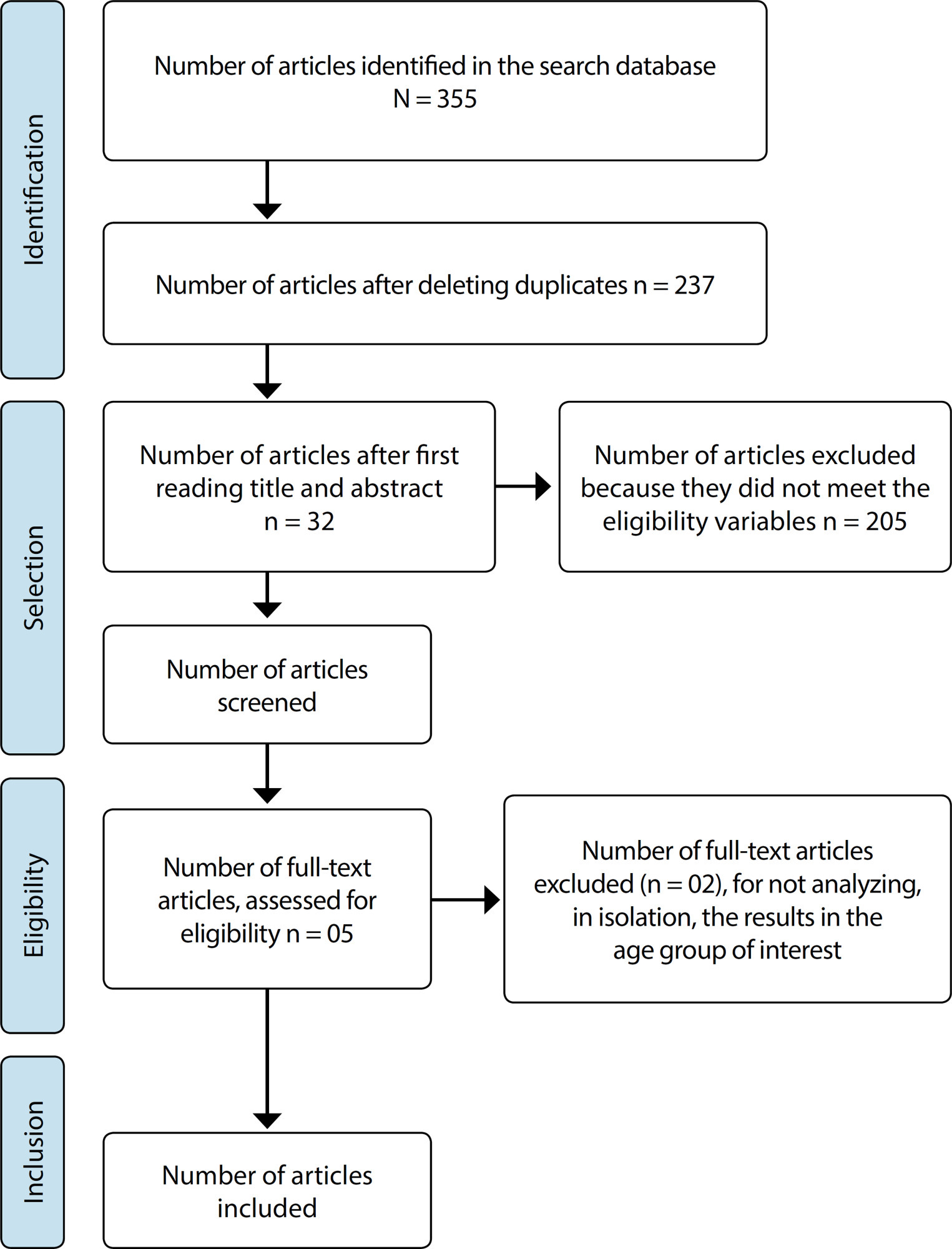
-
ORIGINAL ARTICLE07-30-2021
Curricular reforms in the transformation of nursing teaching in a federal university
Revista Brasileira de Enfermagem. 2021;74(4):e20201242
Abstract
ORIGINAL ARTICLECurricular reforms in the transformation of nursing teaching in a federal university
Revista Brasileira de Enfermagem. 2021;74(4):e20201242
DOI 10.1590/0034-7167-2020-1242
Views1See moreABSTRACT
Objectives:
to discuss the curricular reforms adopted for nursing teaching in Brazil, from 1969 to 2019.
Methods:
historical, qualitative approach using the thematic oral history and document research. 13 interviews were carried out with graduation nursing professors from a federal university in the South of Brazil. The document sources were the political-pedagogical projects of the course and their associated documents. Minayo’s thematic analysis was used.
Results:
nursing curricula delineates the profile of the professional that must be formed and are reviewed in order to be adapted to social and educational changes, showing the scientific and professional potential of the nurse. Curricular reforms consider the quality of nursing formation.
Final Considerations:
the structure of the curriculum and the reforms that took place emerged according to the historical, political, epidemiological and social context demanded from the profession, to attend to the demands of society and to the work market.
-
ORIGINAL ARTICLE11-29-2022
Changes implemented in the work environment of nurses in the COVID-19 pandemic
Revista Brasileira de Enfermagem. 2022;75:e20201381
Abstract
ORIGINAL ARTICLEChanges implemented in the work environment of nurses in the COVID-19 pandemic
Revista Brasileira de Enfermagem. 2022;75:e20201381
DOI 10.1590/0034-7167-2020-1381
Views0See moreABSTRACT
Objective:
to describe the changes implemented in the work environment of nurses in university hospitals considering the COVID-19 pandemic.
Methods:
this qualitative and descriptive research was developed from an online survey with 75 nurses from three Brazilian university hospitals. Data processing occurred through textual analysis with the aid of software IRAMUTEQ.
Results:
five semantic classes were obtained: Organization of units for exclusive care of patients with COVID-19; Adaptations in the use of personal protective equipment; Physical structure adaptation; Care flow institution; Increased number of beds and training courses. Final considerations: the results show the effort of healthcare and nursing professionals/managers in the development of structural adaptations and reorganizations of care processes, in the hospital context, to respond with quality and efficiency to the demands arising from the COVID-19 pandemic.
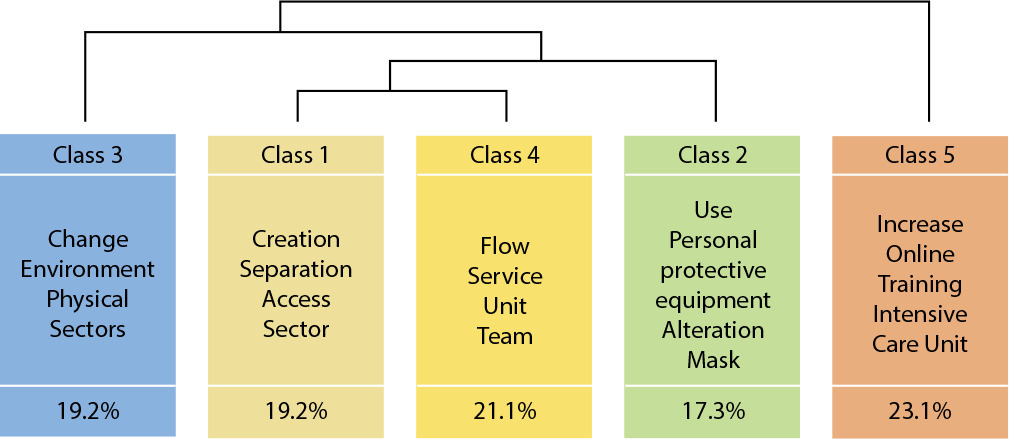
-
ORIGINAL ARTICLE10-21-2019
Permanent education for good practices in the prevention of pressure injury: almost-experiment
Revista Brasileira de Enfermagem. 2019;72(6):1646-1652
Abstract
ORIGINAL ARTICLEPermanent education for good practices in the prevention of pressure injury: almost-experiment
Revista Brasileira de Enfermagem. 2019;72(6):1646-1652
DOI 10.1590/0034-7167-2018-0778
Views0See moreABSTRACT
Objective:
To verify the effectiveness of the educational intervention through the evaluation of nurses’ knowledge about prevention of pressure injury.
Method:
A quasi-experimental study with a single group, carried out with 95 nurses from a teaching hospital in the interior of Minas Gerais, in August and September 2017. As a teaching strategy, the active methodology and hybrid teaching were used, based on the reference of the Method of the Arch of Charles Maguerez. Data were collected from a validated instrument, called the Pieper Knowledge Test, and analyzed by descriptive statistics and Student’s t-test with significance level of p <0.001.
Results:
The mean number of correct answers obtained by the nurses was 78.8% in the pre-test and 88.8% in the post-test, and the difference was statistically significant (p <0.001).
Conclusion:
The educational intervention developed was effective, since it contributed to the improvement of nurses’ knowledge.
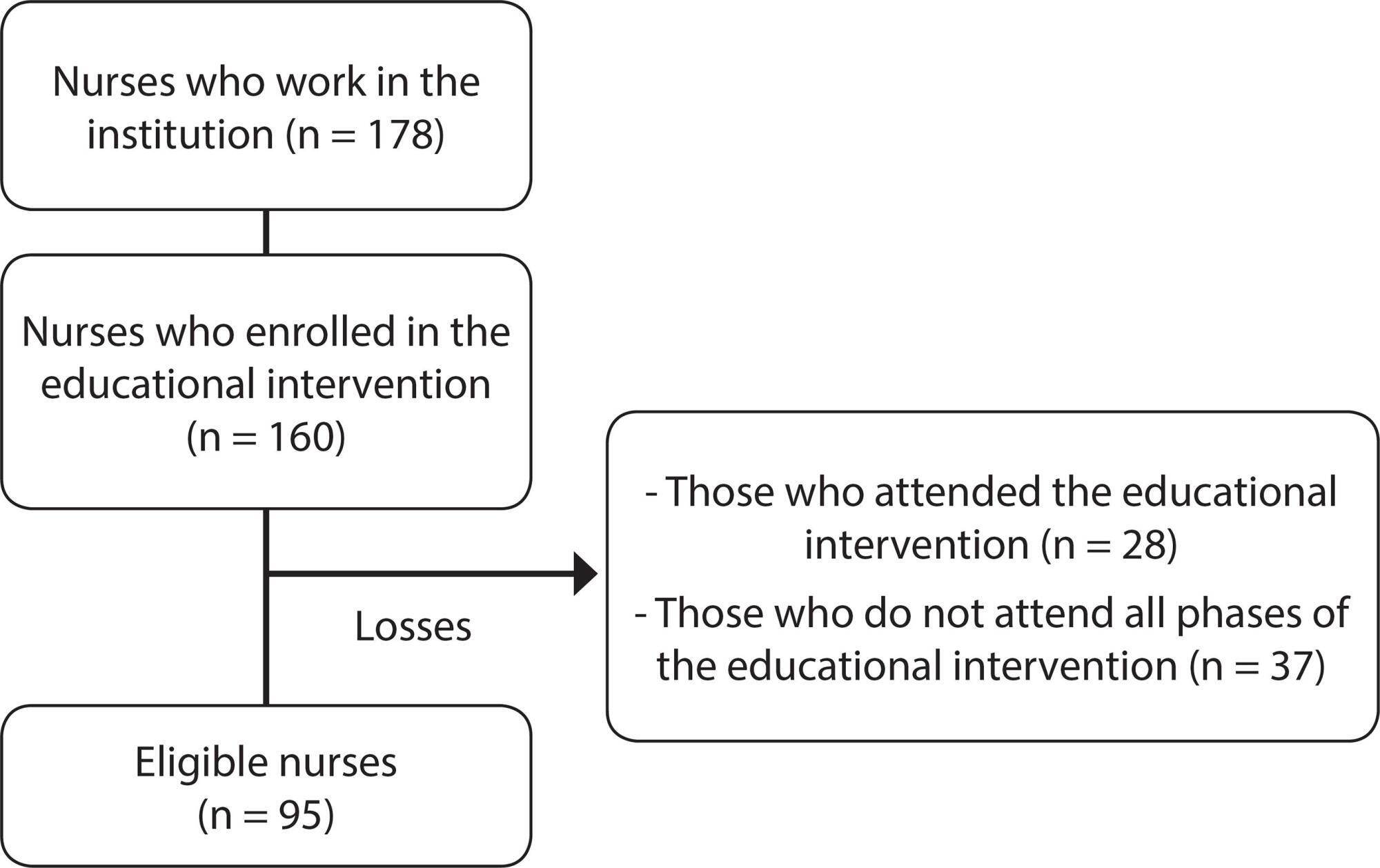
-
ORIGINAL ARTICLE12-05-2019
Nurse care for the hospitalized elderly’s spiritual dimension
Revista Brasileira de Enfermagem. 2019;72:236-242
Abstract
ORIGINAL ARTICLENurse care for the hospitalized elderly’s spiritual dimension
Revista Brasileira de Enfermagem. 2019;72:236-242
DOI 10.1590/0034-7167-2018-0685
Views0See moreABSTRACT
Objective:
to analyze the nurse care for the spiritual hospitalized elderly’s dimension.
Method:
a qualitative study, based on Jean Watson’s Theory of Human Caring. The study included 17 nurses working in a geriatric center in Salvador City, Bahia State, Brazil. The collection of testimonies occurred between January and April of 2018, through an interview.
Results:
spiritual care were dialogue, encouragement and respect for religious activities, embracement, empathy. One of the obstacles to providing this care was the lack of preparation in accessing the elderly’s spiritual dimension.
Final considerations:
spirituality is a dimension of human and holistic nursing care. Caring for the spirit contributes to foster transpersonal care. The difficulty may be in the lack of nurses’ preparation. It is necessary that they cultivate and live their own spirituality, transmitting the understanding in each care relationship.
-
EXPERIENCE REPORT04-03-2020
Use of webQDA software on qualitative nursing research: an experience report
Revista Brasileira de Enfermagem. 2020;73(3):e20180411
Abstract
EXPERIENCE REPORTUse of webQDA software on qualitative nursing research: an experience report
Revista Brasileira de Enfermagem. 2020;73(3):e20180411
DOI 10.1590/0034-7167-2018-0411
Views0See moreABSTRACT
Objectives:
to report the user experience of the webQDA software in the support of qualitative data analysis about health literacy of older adults.
Methods:
quasi-experimental research developed from January 2014 to January 2015, with 118 older adults, all of whom were interviewed to assess the level of health literacy. Interviews were carried out before and after four educational interventions, according to Freire’s method named Culture Circle. The interviews were transcribed and entered in the software, which highlighted the analytical categories.
Results:
the systems of sources, interpretative encoding and questioning of the data available in the software allowed the construction of three categories for the literacy levels and four categories for their dimensions.
Final considerations:
We concluded that the webQDA software enables the structured encoding of qualitative materials, ensuring faster and effective management of data with systematization and analytical transparency.
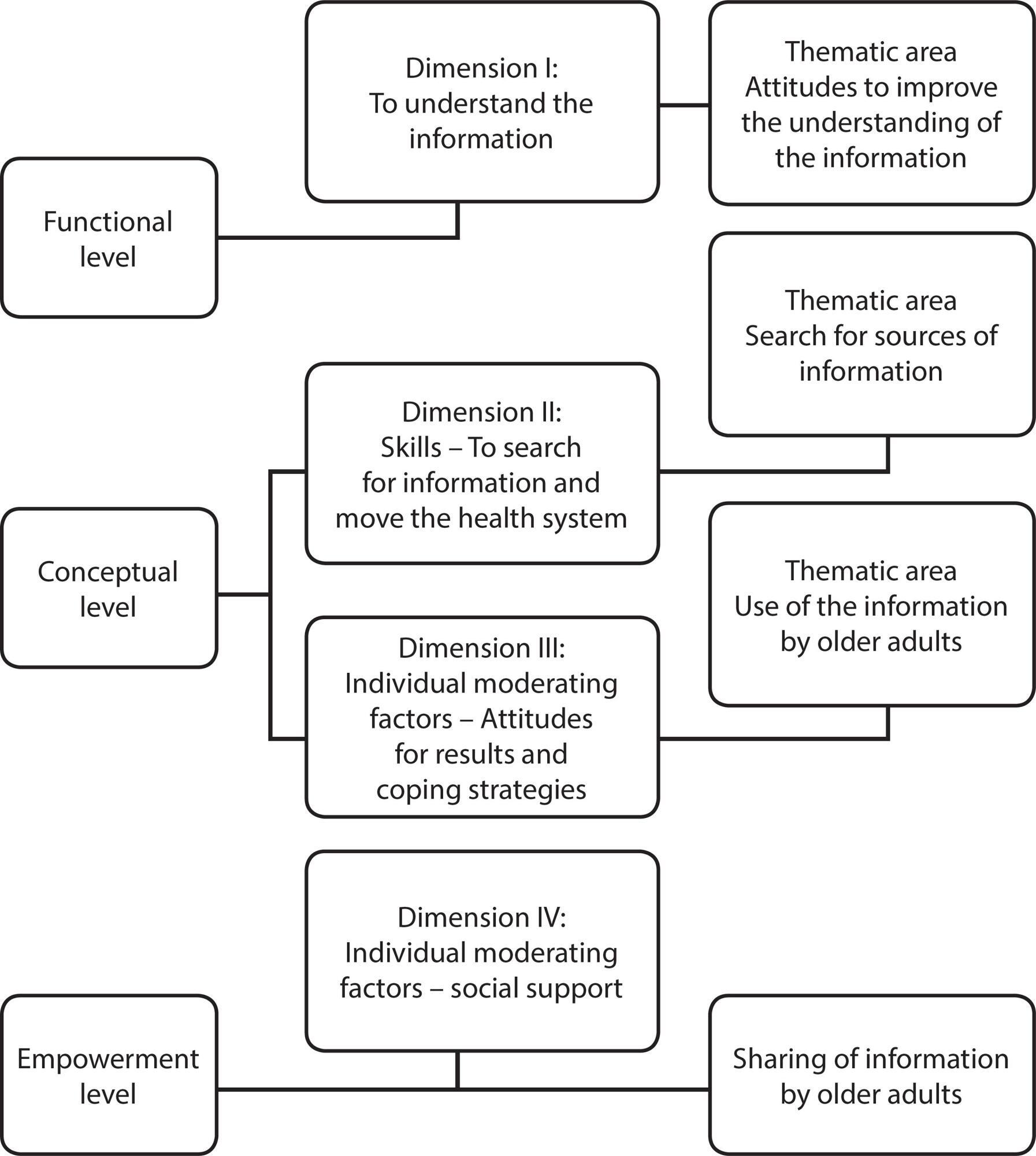
-
Concept analysis of Perioperative Thirst for the development of a new nursing diagnosis
Revista Brasileira de Enfermagem. 2021;74(1):e20200065
Abstract
Concept analysis of Perioperative Thirst for the development of a new nursing diagnosis
Revista Brasileira de Enfermagem. 2021;74(1):e20200065
DOI 10.1590/0034-7167-2020-0065
Views0See moreABSTRACT
Objectives:
to analyze the perioperative thirst concept for the development of a new diagnostic structure according to NANDA International.
Methods:
a concept analysis study based on the framework proposed by Walker and Avant, instrumentalized through an integrative literature review based on SCOPUS, CINAHL, PUBMED, LILACS, and WOS. The elaboration of the diagnostic structure followed NANDA International guidelines.
Results:
41 studies were analyzed revealing that perioperative thirst is prevalent and intense, having visceral and behavioral attributes as the core of the concept. Antecedents indicate that surgical patients are vulnerable to thirst; and consequents 16 signs and symptoms were organized and model cases were developed. A diagnostic structure has been developed for perioperative thirst.
Final Considerations:
concept analysis allowed language standardization that describes thirsty patients, helping the identification, planning of actions and communication of perioperative nursing care.
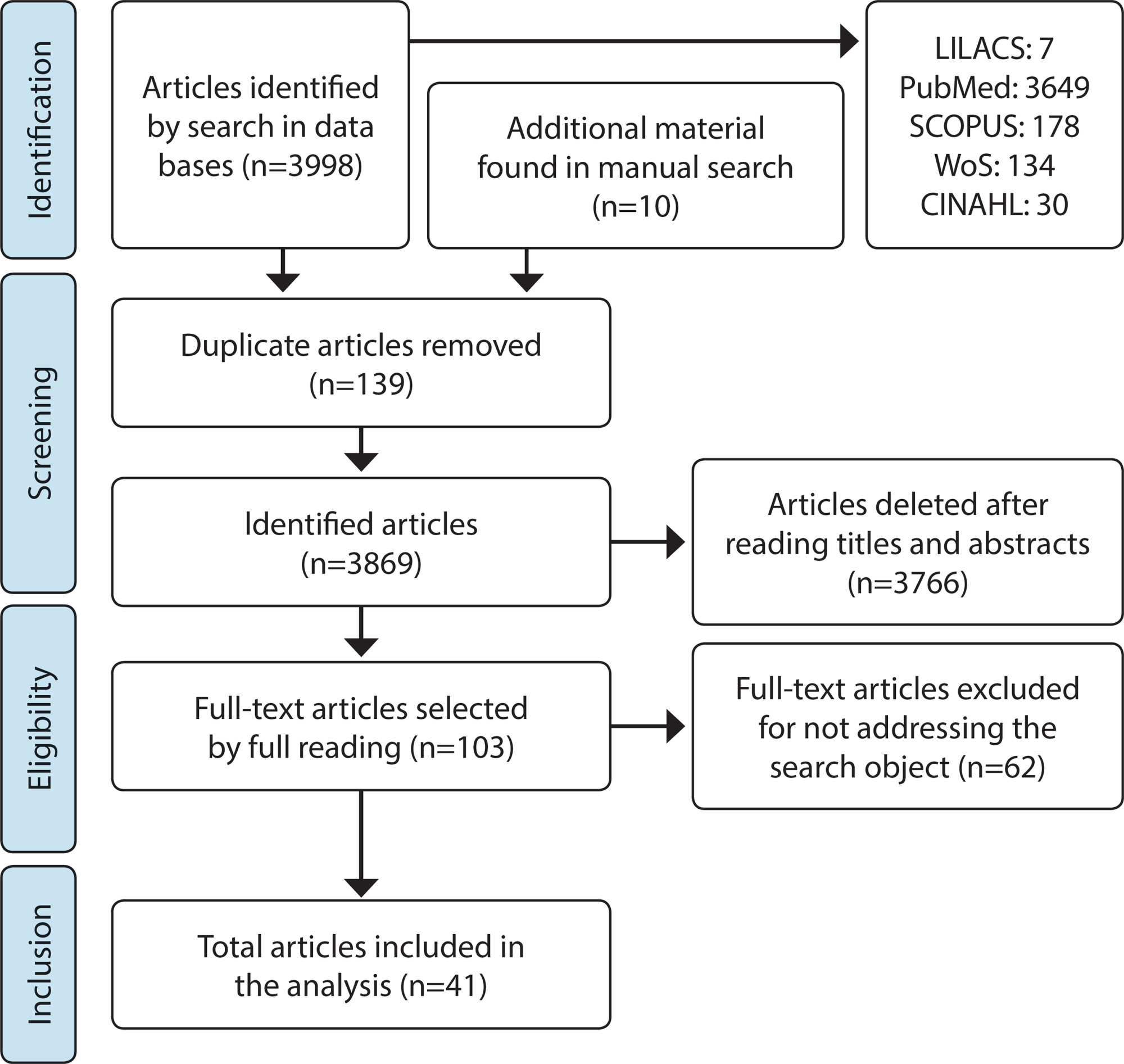
-
REFLECTION05-11-2022
Nursing Process in the Brazilian context: reflection on its concept and legislation
Revista Brasileira de Enfermagem. 2022;75(6):e20210898
Abstract
REFLECTIONNursing Process in the Brazilian context: reflection on its concept and legislation
Revista Brasileira de Enfermagem. 2022;75(6):e20210898
DOI 10.1590/0034-7167-2021-0898
Views0ABSTRACT
Objectives:
to reflect on the global understanding of the Nursing Process concept, with emphasis on the Brazilian context.
Methods:
a reflection article, aligned with the vision and expertise of researchers who are members of the Nursing Process Research Network.
Results:
the reflection is presented in two main topics: The evolution of Systematization of Nursing Care X Nursing Process concepts and its consonance with national and international practices, and Brazilian legislation; The Nursing Process concept realignment in Brazilian legislation in line with current care, teaching and research practices. Final Considerations: the reflections were oriented to the Nursing Process’ conceptual, normative and legal issues, including elements of its historical evolution, and, with that, pointed to the need to modify the Brazilian regulation on the Nursing Process.
Keywords:Education, NursingLegislationNursingNursing CareNursing ProcessStandardized Nursing TerminologySee more -
ORIGINAL ARTICLE09-07-2020
Creation and validation of a visual educational technology content for lactation physiology learning
Revista Brasileira de Enfermagem. 2020;73(6):e20190564
Abstract
ORIGINAL ARTICLECreation and validation of a visual educational technology content for lactation physiology learning
Revista Brasileira de Enfermagem. 2020;73(6):e20190564
DOI 10.1590/0034-7167-2019-0564
Views0ABSTRACT
Objective:
to create and validate a visual educational technology content for lactation physiology learning.
Method:
a methodological study that contemplated the stages of content creation and validation guided by the conceptual model of Knowledge Translation into action. The creation took place in partnership with the educational technology center of the project’s home institution. The validation was attended by 27 judges with experience in the obstetric, neonatal, pediatric or maternal and child areas and in the theme of breastfeeding.
Results:
an educational technology covered animation and video techniques to locate, respectively, elements of lactation physiology and the population involved. An Overall Content Validity Index of 0.84 was obtained.
Conclusion:
the visual educational technology for lactation physiology learning has been validated in content as a tool to introduce the theme and mediate health education actions that can have a positive impact on breastfeeding.
Keywords:Audiovisual ResourcesEducational TechnologyHealth EducationLactationTranslational Medical ResearchSee more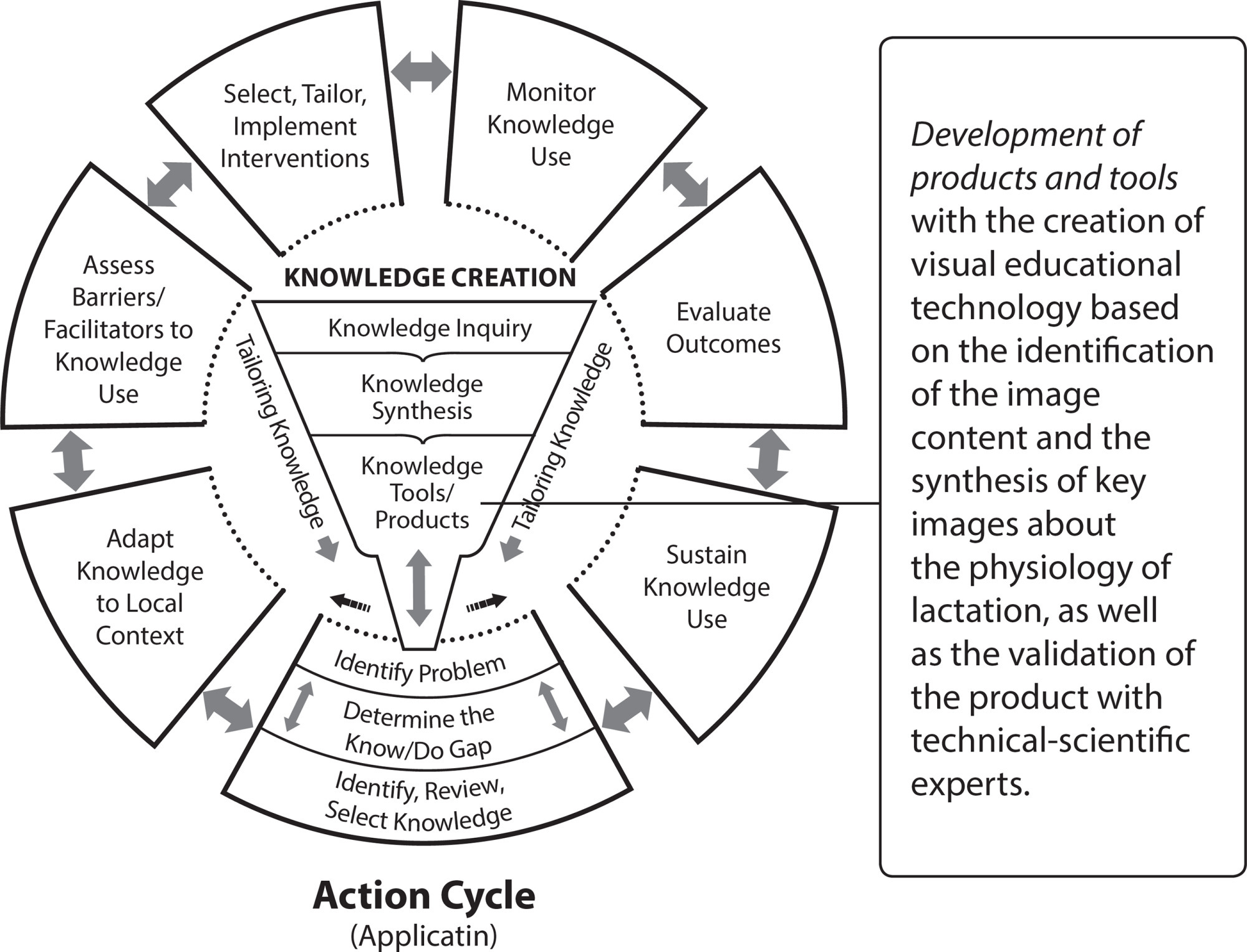
-
ORIGINAL ARTICLE08-20-2021
Risk of suicide among nursing students
Revista Brasileira de Enfermagem. 2021;74(6):e20200867
Abstract
ORIGINAL ARTICLERisk of suicide among nursing students
Revista Brasileira de Enfermagem. 2021;74(6):e20200867
DOI 10.1590/0034-7167-2020-0867
Views0See moreABSTRACT
Objectives:
to identify the risk and degree of risk of suicide in nursing students of a public institution in the countryside of Pernambuco, Brazil.
Methods:
this was a cross-sectional, quantitative research conducted with 150 students. For data collection, a sociodemographic questionnaire and the instrument, M.I.N.I. – Brazilian version 5.0.0 – Module C – Risk of suicide were used. Statistical analyses were performed with IBM(® )SPSS(®), version 23.
Results:
53.3% of nursing students had a risk of suicide, of which 20.7% had a high risk. Moreover, 22.67% reported previous suicide attempt. It is noteworthy that students without a partner have a higher risk of suicide (56.8%) than those with a partner (29.4%).
Conclusions:
it is perceived the need to develop programs that identify students at risk of suicide in higher education institutions, in order to raise awareness of the problem and implement policies to promote mental health in the academia.
Search
Search in:
Nuvem de Tags
Aged (144) Atenção Primária à Saúde (239) COVID-19 (104) Cuidados de Enfermagem (269) Educação em Enfermagem (151) Educação em Saúde (139) Enfermagem (930) Estudos de Validação (131) Health Education (144) Idoso (208) Mental Health (149) Nursing (987) Nursing Care (306) Patient Safety (151) Primary Health Care (284) Qualidade de Vida (104) Quality of Life (106) Saúde Mental (145) Segurança do Paciente (150) Validation Studies (108)



